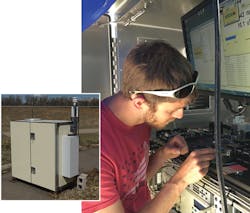Lidar: Differential absorption lidar demands high-power, narrowband DBR sources

Water vapor plays a role in many atmospheric processes and is a primary driver of weather. Atmospheric water-vapor concentrations span more than four orders of magnitude from the planetary boundary layer—where high-impact weather initiates—to lower levels in the upper troposphere and lower stratosphere, where water vapor has significant and long-term impacts on the Earth's radiation budget.
NASA Langley has been fielding airborne water-vapor differential-absorption lidar (DIAL) systems for more than 30 years in support of atmospheric chemistry, high-impact weather, and climate process studies, with an end goal of implementing a water-vapor DIAL system in space for weather and climate applications. In collaboration with the National Center for Atmospheric Research (NCAR) and Montana State University, NASA researchers are also working towards implementing a nationwide water-vapor-profiling network to improve weather forecasting and climate modeling with an automated, eye-safe, low-cost, and compact ground-based water-vapor DIAL system. NASA recognizes that the airborne-, space-, and ground-based water-vapor DIAL systems share a common requirement for frequency-agile, narrowband, rugged seed lasers that are used to injection-seed higher-power pulsed lasers.
DBR-based injection-seed lasers
To meet NASA's requirements, Photodigm (Richardson, TX) received a phase I and subsequent phase II NASA Small Business Innovation Research (SBIR) award to improve the laser structure and fabrication technology for the proprietary single-growth epitaxy and monolithic grating process used in its distributed Bragg reflector (DBR) laser diodes.1
The DIAL instrument requires two closely spaced wavelengths, one of which is precisely tuned to the water vapor absorption line. The other wavelength, approximately 0.1 nm away, is tuned off-line. The DBR lasers, with a linewidth of <1 MHz, must be frequency-agile to be precisely tuned to the desired wavelength. This spectral purity, coupled with high-finesse etalons in the DIAL instrument, improves performance during daytime and cloudy conditions by reducing background radiation.
To achieve the required specifications of 5 μJ pulse energy at 9 kHz repetition rate, the DBRs are used as seed lasers with their 50–100 mW outputs amplified using tapered semiconductor optical amplifiers. The combination of frequency agility, a precise, spectrally pure wavelength, and high-energy pulses maximizes signal-to-noise and ensures that the differential between the return signals is because of molecular absorption only. Furthermore, eye safety is inherent in the expanded beam. Because water vapor has multiple absorption lines in the 700–950 nm region, the lines chosen for analysis must have high absorptivity and be insensitive to atmospheric conditions. The 828.1 nm spectral line has been selected for ground-based systems, and the 817 nm line is optimal for airborne and satellite-based DIAL. Photodigm will also be developing the 817 nm DBRs as part of this effort.
Current DIAL systems use free-space lasers that require bulk conditioning optics with a large footprint that are subject to misalignment and contamination. Photodigm is customizing mission-specific packaging with optically isolated output and single-mode fiber coupling to reduce alignment sensitivity and risk of contamination.
"Whereas earlier work was performed using external-cavity diode lasers and injection-seeded Ti:sapphire lasers, our monolithic and scalable DBR lasers are enabling the development of a cost-effective, rugged, and fieldable water-vapor-profiling network," says Annie Xiang, director of products at Photodigm and principal investigator on the SBIR program. "This will allow NASA to realize the potential societal benefits of improved weather forecasting and climate modeling envisioned by a nationwide water-vapor-profiling network."
REFERENCE
1. See http://sbir.gsfc.nasa.gov/SBIR/abstracts/15/sbir/phase1/SBIR-15-1-S1.01-9731.html.
About the Author

Gail Overton
Senior Editor (2004-2020)
Gail has more than 30 years of engineering, marketing, product management, and editorial experience in the photonics and optical communications industry. Before joining the staff at Laser Focus World in 2004, she held many product management and product marketing roles in the fiber-optics industry, most notably at Hughes (El Segundo, CA), GTE Labs (Waltham, MA), Corning (Corning, NY), Photon Kinetics (Beaverton, OR), and Newport Corporation (Irvine, CA). During her marketing career, Gail published articles in WDM Solutions and Sensors magazine and traveled internationally to conduct product and sales training. Gail received her BS degree in physics, with an emphasis in optics, from San Diego State University in San Diego, CA in May 1986.